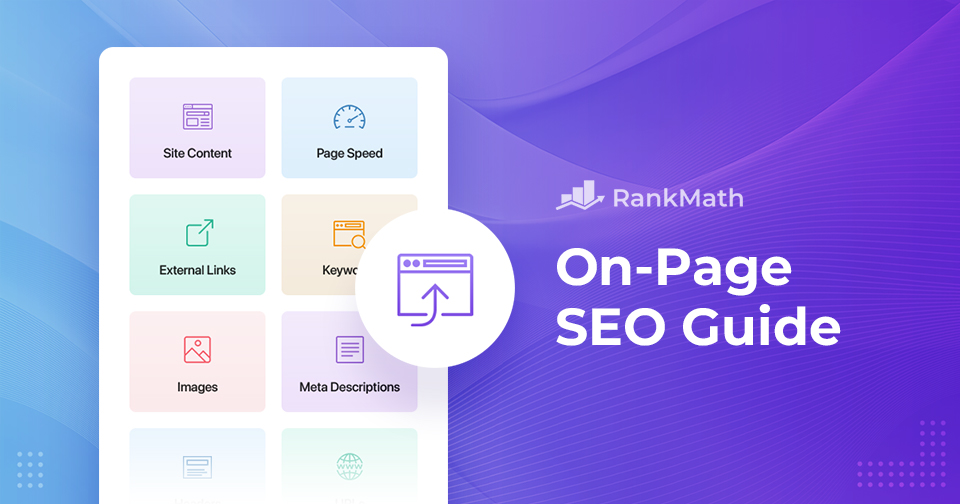Imagine you have a fantastic shop, but it’s hidden in a place where no one can find it. That’s a bit like having a website not optimized for search engines.
On-page SEO is the key to changing that and ensuring your website is the main attraction on the internet.
Whether you’re a seasoned marketer or just a beginner, this post is designed to provide you with a solid understanding of on-page SEO techniques and how they can benefit your website.
By the end of this post, you’ll have all the knowledge you need to optimize your web pages effectively and improve your search engine rankings.

So, without any further ado, let’s get started.
Table Of Contents
1 What is On-Page SEO?
On-page SEO is everything you and I do directly on a web page to help it rank better in search engines and give visitors a great experience.
It’s about making sure each page is easy to read, loads quickly, and clearly tells search engines what it’s about.
When you work on on-page SEO, you’re focusing on things like optimizing your titles, headings, and meta descriptions, using the right keywords naturally, improving your images, and structuring your content so it’s simple to navigate.
I like to think of it as giving both your readers and search engines a smooth, enjoyable journey through your site.
The better you get at on-page SEO, the more visible your content becomes, and the more likely visitors are to click, stay, and take action.
2 Importance of On-Page SEO
No matter how great your content is, it won’t get the attention it deserves if search engines can’t understand it. That’s where on-page SEO comes in; it’s the bridge between your content and the audience searching for it.
When you focus on on-page SEO, you’re making it easier for search engines to figure out what your page is about and why it’s valuable. This means your pages have a better chance of ranking higher, attracting the right audience, and keeping them engaged once they arrive.
For you, that translates into more visibility, more clicks, and ultimately, more opportunities to grow your brand or business.
Without strong on-page SEO, you’re basically leaving your website hidden in the crowd, hoping your audience somehow stumbles upon it. With it, you’re putting up a big, clear sign saying, Here I am—come check me out!
3 How to Perform On-Page SEO
Now that you understand what on-page SEO is, it’s time to put it into action. Remember, this isn’t just about attracting visitors to your website; it’s about keeping them there with content that answers their questions and meets their needs.
Let’s start with one of the most important steps: keyword research.
3.1 Keyword Research
Keyword research is where your SEO journey begins. It’s how you figure out the exact words and phrases people type into search engines, so you can create content that matches their needs.
When I do keyword research, I always start with user intent in mind. You should do the same. Ask yourself:
- Are people looking for information? (Example: “How to groom a poodle”)
- Are they ready to buy something? (Example: “Buy a poodle grooming kit”)
- Are they searching for local services?
Once you know the intent, you can create your content to match it.
Rank Math PRO’s Search Intent feature simplifies intent-based optimization, helping your content rank better. Clicking the Show Intent label beside your keyword instantly reveals its intent.
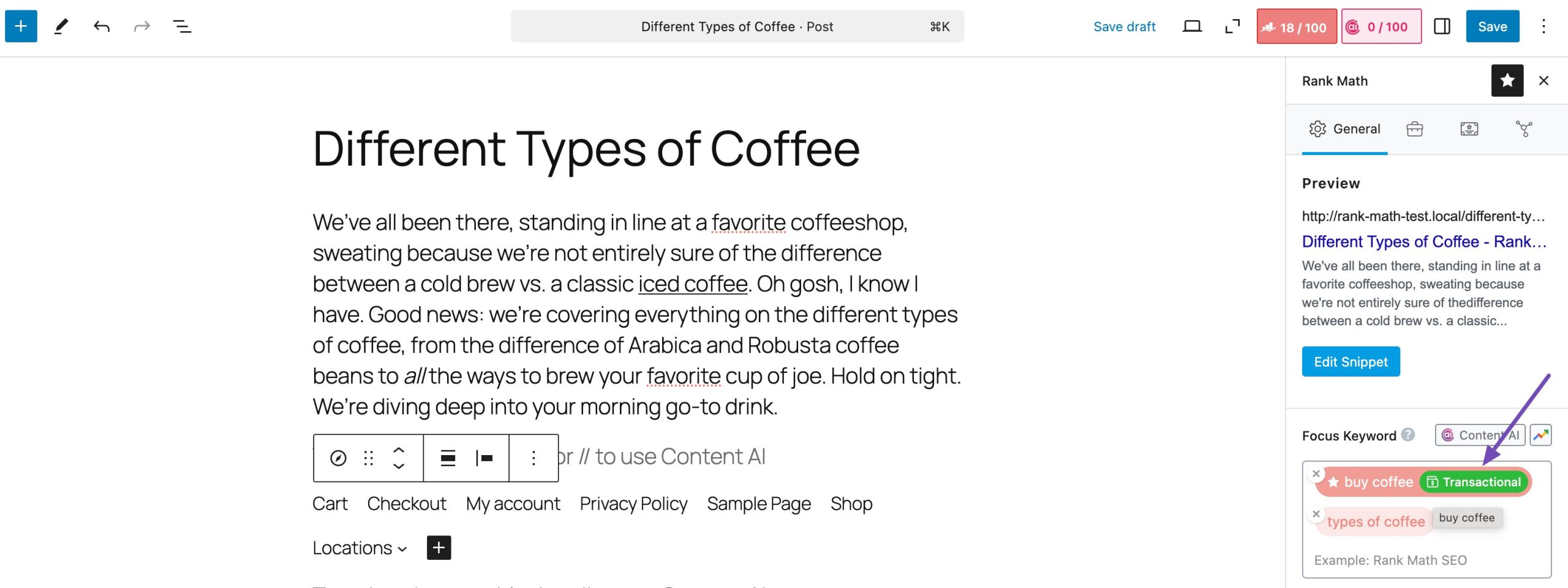
Start by brainstorming potential keywords relevant to your website, products, or services. These can be single words (short-tail keywords) or longer phrases (long-tail keywords).
- Short-tail keywords are broad terms like “shoes” or “travel.” They attract a lot of searches but also a lot of competition.
- Long-tail keywords are more specific, like “best running shoes for flat feet” or “budget-friendly travel destinations in Italy.” They bring in fewer visitors, but those visitors are more likely to take action.
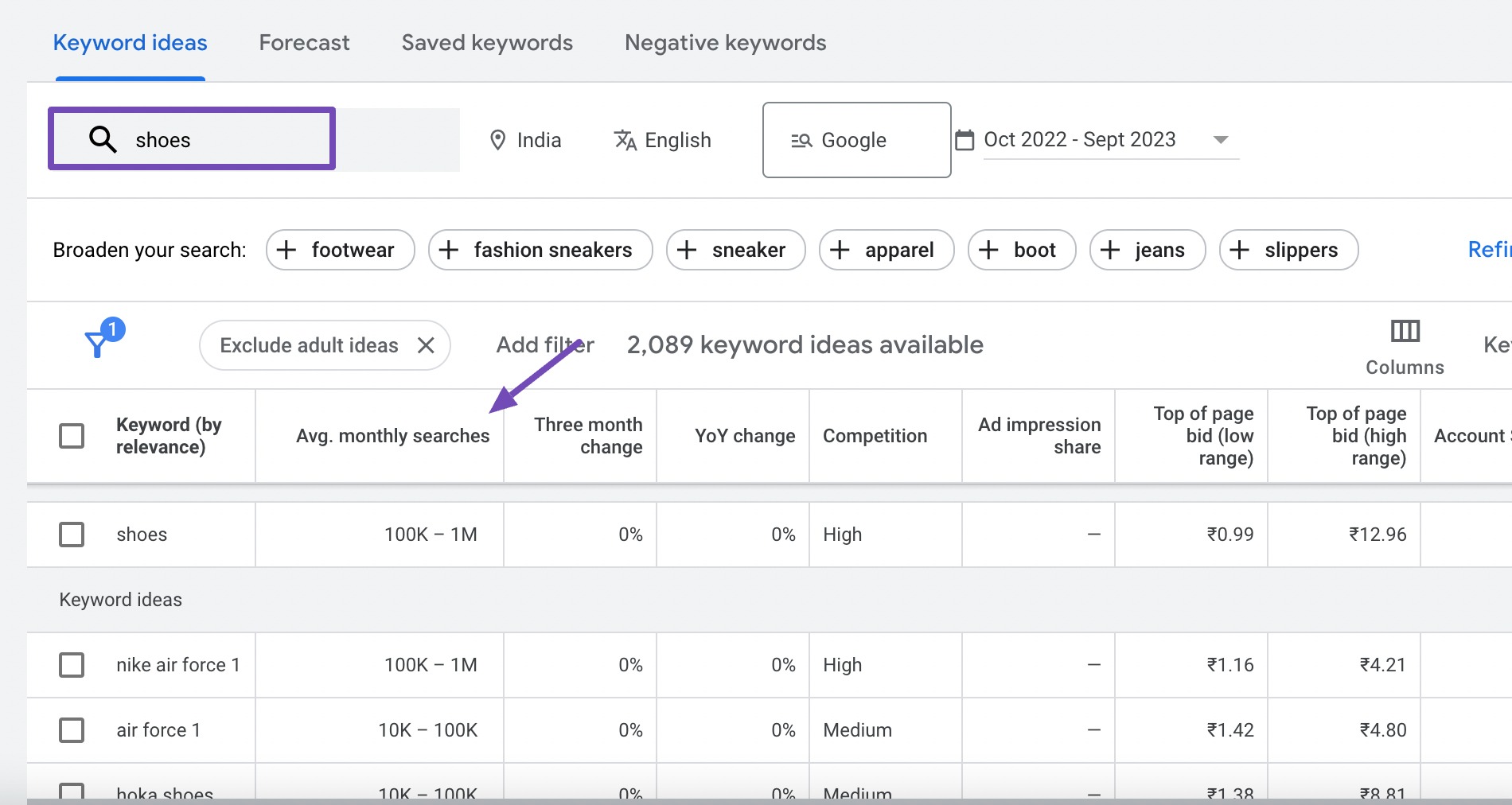
If I were selling running shoes, I’d choose the long-tail keyword “best running shoes for flat feet” over just “shoes” because it attracts visitors who are ready to buy exactly what I offer.
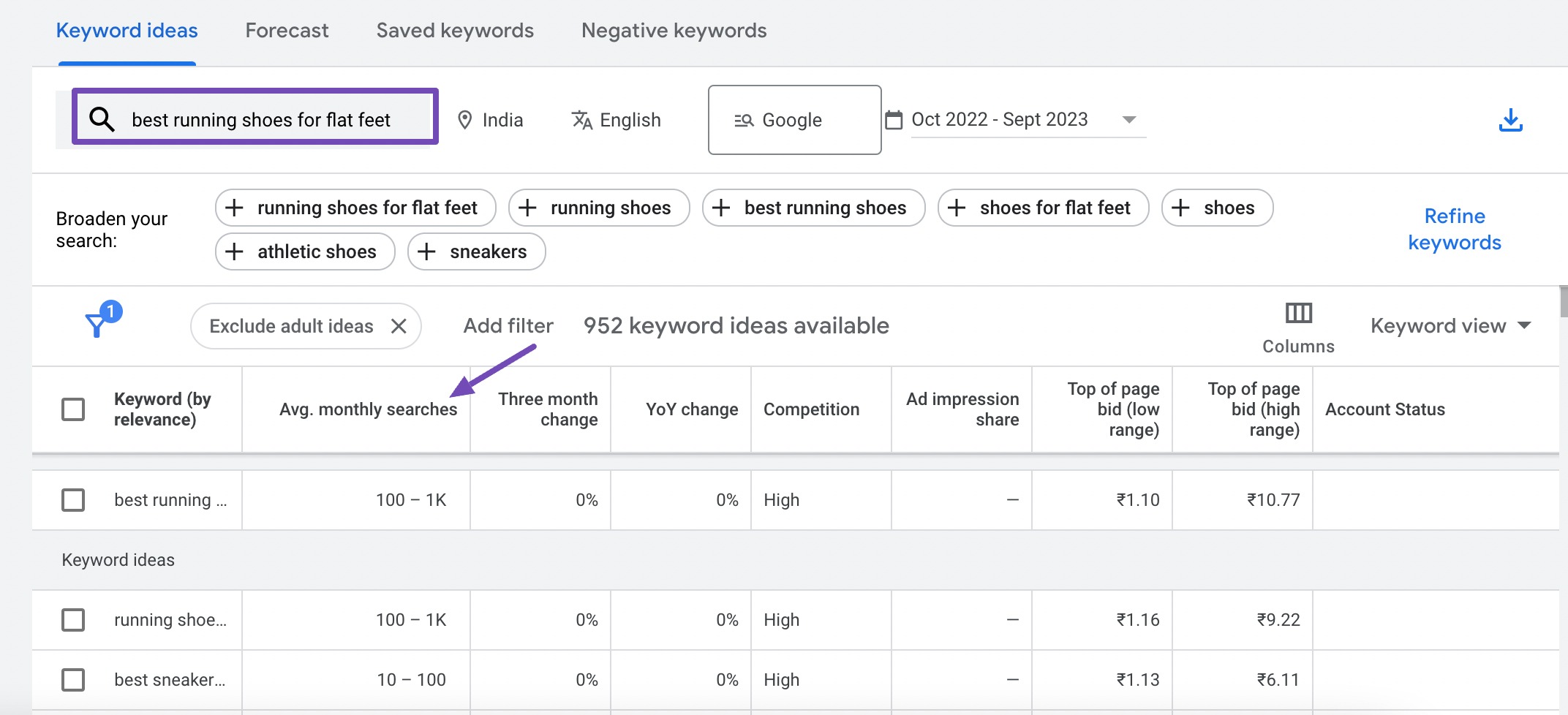
Evaluate the competitiveness of keywords. Highly competitive keywords are harder to rank for, especially for new websites. Focus on a mix of less competitive and moderately competitive keywords. For instance, “Pet supplies online” is highly competitive, but “organic dog food brands” have moderate competition.
Use keyword research tools and platforms like Google Keyword Planner, Ahrefs, or Semrush to expand your list of potential keywords. These tools provide data on keyword search volume, competition, and related terms.
Rank Math makes it extremely simple to perform keyword research. Rank Math’s integration with the Google Trends tool (available in Rank Math PRO) allows you to examine keyword search trends and make comparisons.
You can also gain valuable insights into your competitor’s SEO strategies using Rank Math’s SEO Analyzer.
Finally, create high-quality, informative, engaging content around your chosen keywords. This content should answer user queries, solve problems, or provide valuable information.
Quick Actionable Tips for Keyword Research:
- Understand User Intent – Match your keywords to what people are really searching for.
- Prioritize Long-Tail Keywords – Easier to rank for and more targeted.
- Check the Competition – Go for a mix of low- and medium-competition keywords.
- Use Tools – They’ll save you time and give you reliable data.
- Keep It Fresh – Review your keywords regularly and update your strategy.
3.2 Content Quality
High search rankings don’t just happen; they’re built on high-quality content. You can use all the right keywords and technical tweaks, but if the content isn’t valuable, original, and engaging, visitors (and search engines) won’t stick around.
Google rewards people-first content, content that genuinely helps readers, answers their questions, and keeps them coming back.
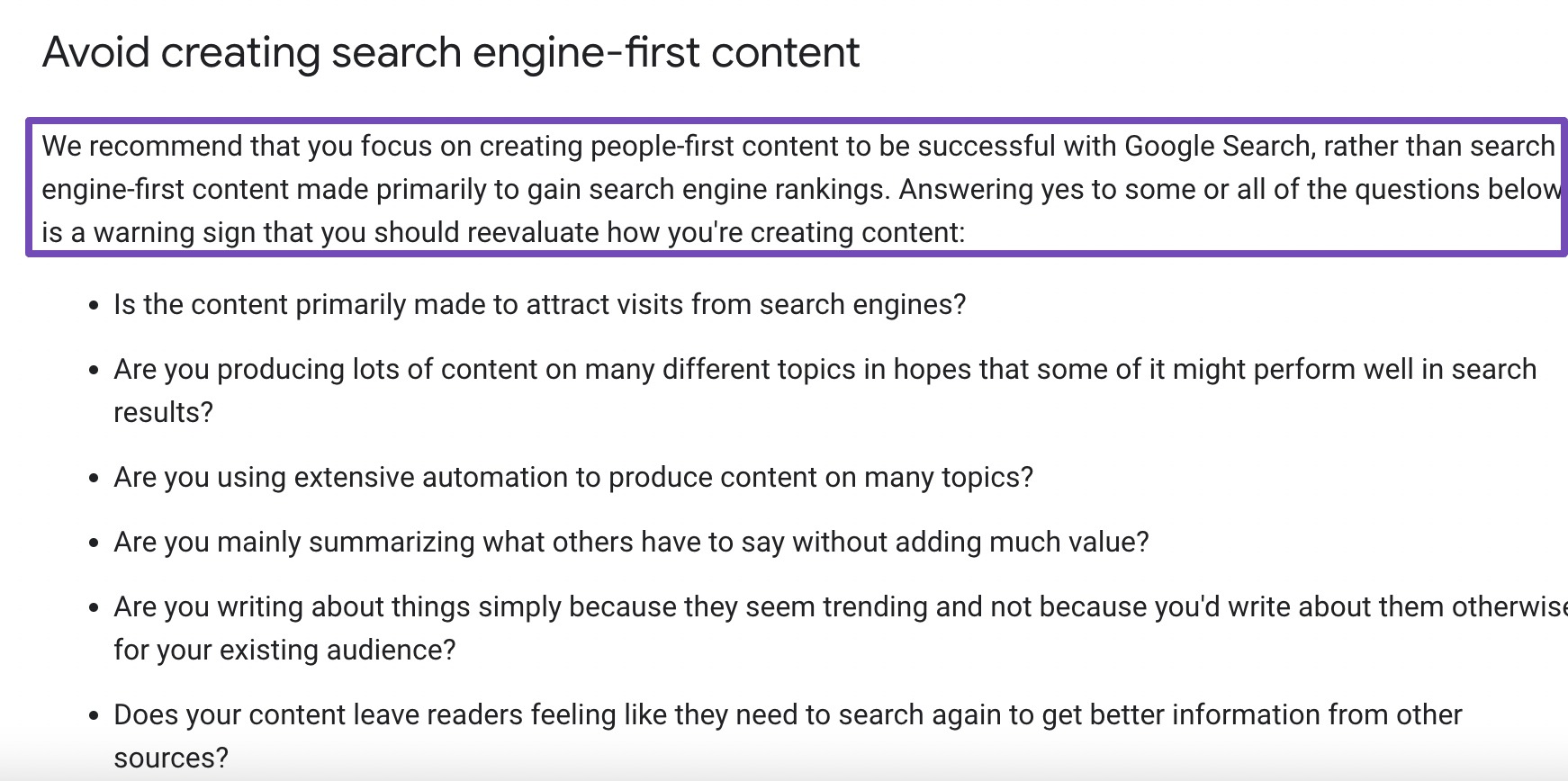
And here’s an interesting trend: AI is helping 47% of creators produce content faster, while 35% are now shifting focus from pumping out more articles to making each one truly worth reading.
When you aim for quality, start by placing your chosen keywords naturally in your titles, headings, and body text. For example, if you’re writing about camping gear, you might use keywords like best camping tents or camping equipment reviews, but only where they fit naturally. Overstuffing keywords doesn’t just make your writing awkward; it can also harm your rankings.
And always prioritize originality. Copying or reusing someone else’s work can damage your credibility and search visibility. Your goal is to create something fresh, distinctive, and genuinely helpful.
Quick Actionable Tips for Content Quality:
- Do Thorough Research – Make sure your content is accurate, reliable, and based on trustworthy sources.
- Write to Engage – Keep your tone clear and conversational so readers stay interested.
- Value Over Volume – A concise, insightful post beats a long one full of fluff.
- Use Keywords Smartly – Place them naturally; avoid stuffing.
3.3 Use Title Tags and Heading Tags
When it comes to on-page SEO, title tags and heading tags are your best friends. They don’t just help search engines understand your content; they guide your readers, too. If you get them right, you’ll improve both your rankings and your click-through rate.
Title Tags
Your title tag is the first thing most visitors see when your page shows up in search results, it’s that clickable blue link. This is often your first chance to make an impression, so make it count.
Here’s what I recommend:
- Include your target keyword naturally so search engines know your page is relevant.
- Make it compelling so users want to click. Think of it as the “headline” for your page in Google.
- Keep it consistent with your brand voice, recognizable titles build trust over time.
- Be clear and relevant so visitors know exactly what they’ll get when they click.
Example: If you’re writing a blog post about 10 Tips for Healthy Eating, your title tag can be:<title>10 Tips for Healthy Eating – Simple Habits for a Healthier Life</title>
Heading Tags (H2, H3, etc.)
Your H1 tag is the main heading on the page; think of it as the page’s headline. You should have only one H1 per page, and it should clearly match the topic. For the healthy eating example, your H1 can be:<h1>10 Tips for Healthy Eating</h1>
Then use H2 tags for your main sections and H3 tags for subpoints. This makes your content easier to read and scan, both for people and search engines.
For instance:
Tip 1: Start with a Balanced Breakfast
Tip 2: Include a Variety of Fruits and Vegetables
If you’re not sure whether your pages are missing H1 tags, you can run a quick site audit with Rank Math’s SEO Analyzer. It will flag any missing headings and help you fix them fast, even if you don’t have Rank Math installed yet.
Quick Actionable Tips for Title Tags and Heading Tags:
- Be Descriptive – Your titles should clearly tell both users and search engines what the page is about.
- Add Keywords Naturally – Don’t force them in, write for people first.
- Follow a Clear Hierarchy – Use H1 for the main title, H2 for sections, H3 for subsections.
- Avoid Duplicate Titles – Every page should have a unique title tag.
3.4 Write Compelling Meta Descriptions
Think of your meta description as your elevator pitch in search results; it’s the short blurb that tells your audience what your page is about and convinces them to click. You can have the best content in the world, but if your meta description is bland (or missing), you’ll lose potential visitors before they even see your site.
Google recommends you always fill out your meta descriptions, and not leave them blank, because they’re your chance to control how your page is presented in search results.
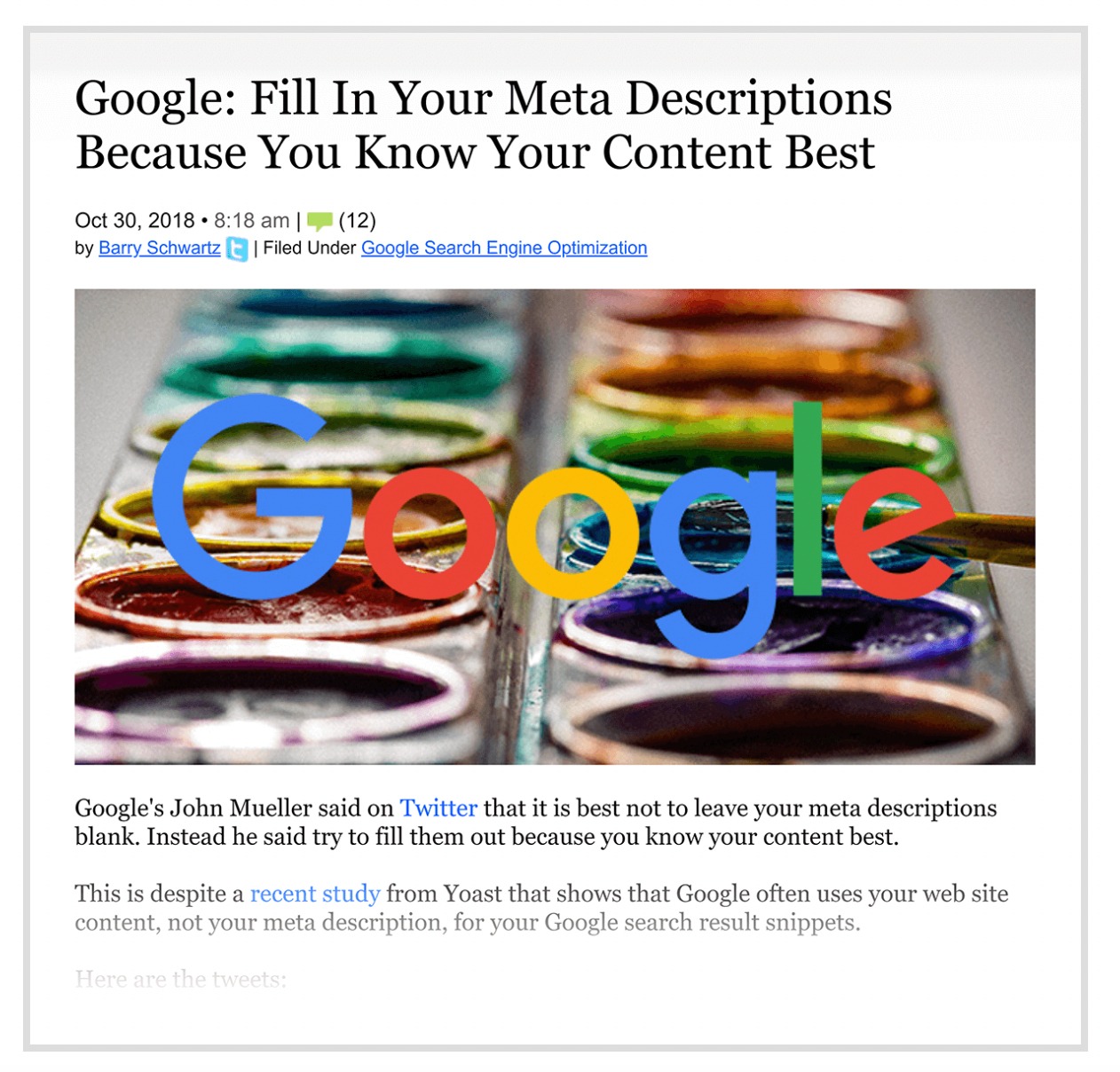
A good meta description should:
- Be under 160 characters so it doesn’t get cut off.
- Clearly summarize your page’s content.
- Include your primary keyword naturally.
- Highlight the value readers will get by clicking.

If you’re using Rank Math, it will automatically check if your focus keyword is in your meta description. If you’re missing it, you’ll see the Focus Keyword not found in your SEO Meta Description alert. You can click Fix with AI, and Rank Math’s Content AI will generate an optimized meta description for you instantly.
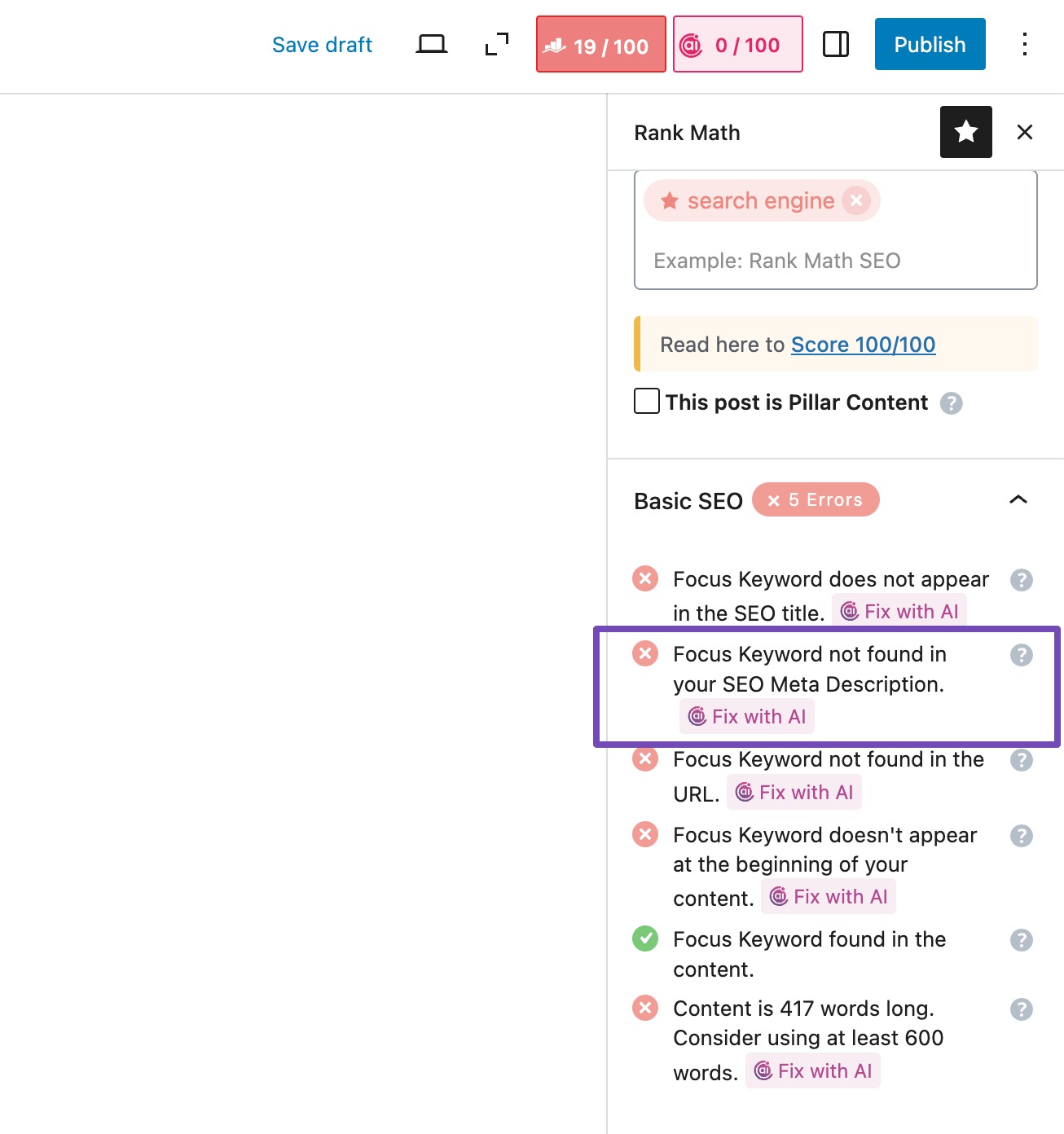
You can use our SEO Description tool to create compelling meta descriptions automatically. You can refer to our article on how to add SEO Meta Titles, Descriptions, and Focus Keywords in Rank Math.
Quick Actionable Tips for Compelling Meta Descriptions:
- Be Concise & Relevant – Stay under 160 characters and match the content of your page.
- Use a Call to Action (CTA) – Invite readers to “Discover,” “Start,” or “Find out” something valuable.
- Include Target Keywords – Naturally weave in your focus keyword for better SEO visibility.
- Show the Benefit – Let the audience know exactly what they’ll gain by clicking your link.
3.5 Optimize Your URLs
Your URL is more than just a web address; it’s a signal to both search engines and your visitors about what your page is all about. A clean, keyword-rich URL can boost your rankings, make your link more clickable, and help people remember it.
Google recommends using clear, relevant words in your URLs. A simple trick? Include your target keyword in the URL slug so search engines instantly understand the topic.
For instance, instead of "www.example.com/category/page1234?var=132&ref=456," use "www.example.com/healthy-smoothie-recipes."
The second one is short, clear, and tells you exactly what to expect.
If you’re using Rank Math, it will automatically check if your focus keyword appears in your URL. When it’s there, you’ll see a green checkmark; when it’s not, you’ll get a red “X” and a prompt to update. You can even click Fix with AI, and Content AI will generate an optimized URL for you in seconds.
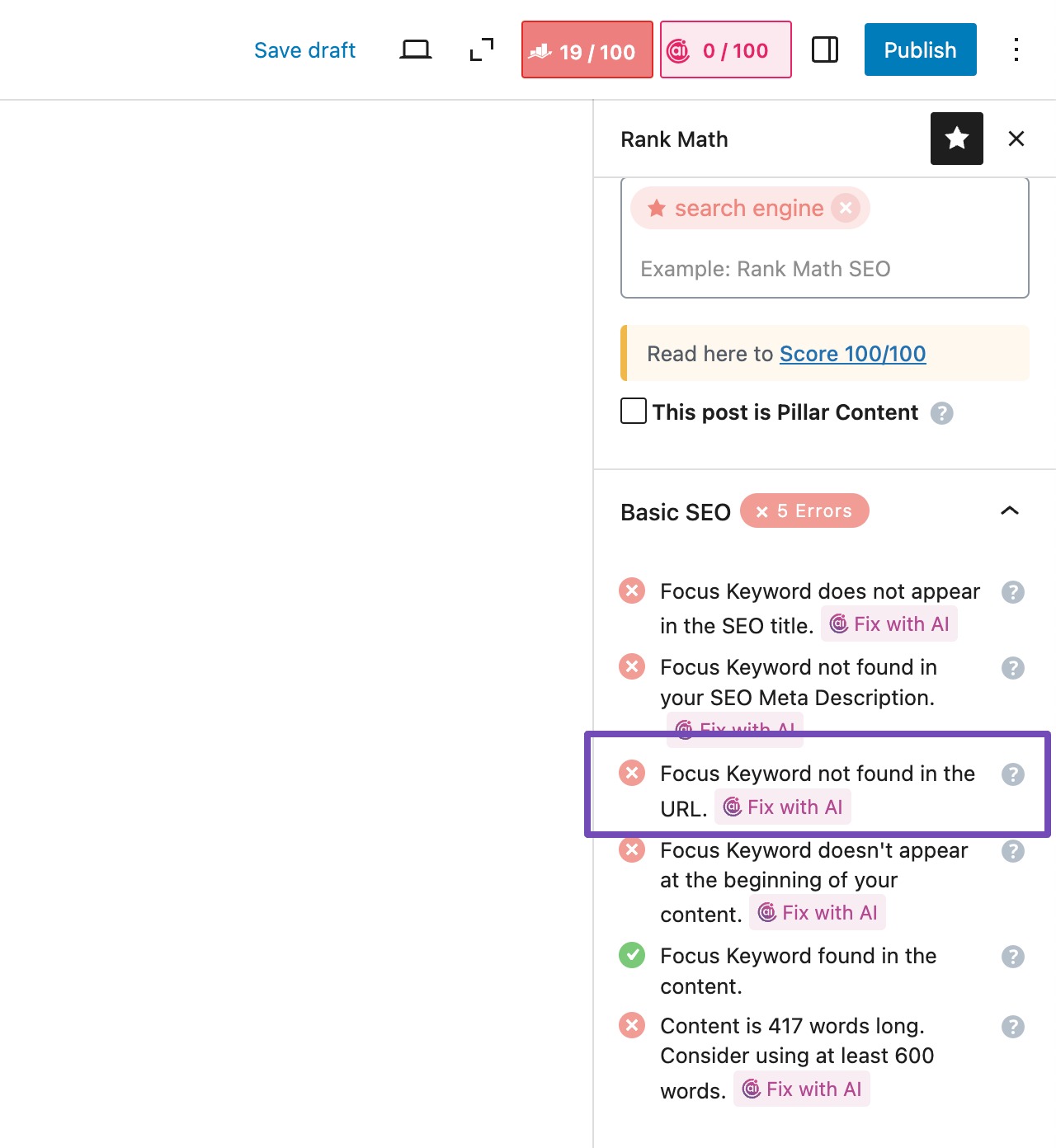
Quick Actionable Tips for Optimizing URLs:
- Keep It Descriptive – Let your URL instantly tell visitors and search engines what the page is about.
- Add Your Keyword – Include your primary keyword naturally, preferably near the start.
- Skip the Clutter – Avoid special characters, numbers, and random strings; use hyphens to separate words.
- Keep It Short – Shorter URLs are easier to read, remember, and share.
3.6 Image Optimization
If you want your pages to load faster, rank higher, and give every visitor a smooth experience, you can’t ignore image optimization. It’s not just about making your site look good; it’s about making your images work for your SEO and your audience.
There are two main things you need to focus on: making your images understandable and making them load quickly.
Alt text is simply a short description of your image, but it serves two powerful purposes.
- It makes your site accessible for visually impaired visitors or anyone with images turned off.
- It helps search engines understand your images, which can land you traffic from image search.
The more accurately you describe the image, the more useful it is for both people and Google.

Large, uncompressed images slow down your site, and nothing makes visitors leave faster than a page that takes forever to load. Compress your images before uploading and choose the right format:
- JPEG for most photos
- PNG for images with transparency
- WebP if you want the best quality-to-size ratio on modern browsers
- AVIF for better compression, and high dynamic range (HDR)
A smaller file size means faster load times, better user experience, and higher chances of ranking well.
Quick Actionable Tips for Optimizing Images:
- Compress Before Uploading – Use tools like TinyPNG or Squoosh to shrink file sizes without losing quality.
- Use Descriptive File Names – Name your file “organic-green-smoothie.jpg” instead of “IMG_4532.jpg” for better SEO.
- Write Helpful Alt Text – Describe the image in a way that’s useful for both users and search engines.
- Pick the Right Format – Match the image type to the right format (JPEG, PNG, WebP) for speed and clarity.
3.7 Use Internal Linking
If you want visitors to stick around longer, find more of your content, and boost your SEO, internal linking is your best friend. It’s like giving your audience a guided tour of your website, showing them exactly where to go next.
When you add links from one page on your site to another, you’re not just helping your readers; you’re also helping search engines understand how your content is connected. This can improve your rankings and spread SEO value across your pages.
Anchor text is simply the clickable text in a link. Instead of vague phrases like “click here” or “read more,” use descriptive text that tells visitors (and Google) exactly what they’ll find when they click.
Descriptive, keyword-rich anchor text makes your content more user-friendly and tells search engines what the linked page is about, without sounding spammy.

If you’re using Rank Math, you can mark articles as Pillar Content. This tells Rank Math these posts are important, evergreen resources. It will then help you create internal links pointing to these pages so they get more attention.
Rank Math can even alert you if a page has no internal links, so you never miss an opportunity to connect your content.
Quick Actionable Tips for Internal Linking:
- Link to Related Content – Keep your links relevant so readers naturally want to click and explore.
- Be Descriptive with Anchor Text – Help readers know exactly what they’re clicking on.
- Don’t Overdo It – Too many links can be distracting; focus on quality, not quantity.
- Check Links Regularly – Update old links so they always lead to fresh, valuable content.
3.8 Use External Linking
When you link to other reputable websites, you’re not sending visitors away; you’re building trust. External linking is simply adding hyperlinks in your content that point to valuable resources outside your own site.
For instance, in an article about health, citing medical journals or institutions like the World Health Organization as external references boosts the credibility of your information.

While external links aren’t a direct ranking booster, they can help your SEO in subtle but important ways.
Search engines notice when you reference relevant, trustworthy sites; it signals that your content is well-researched and connected to other authoritative voices in your niche. That credibility can improve your visibility over time.
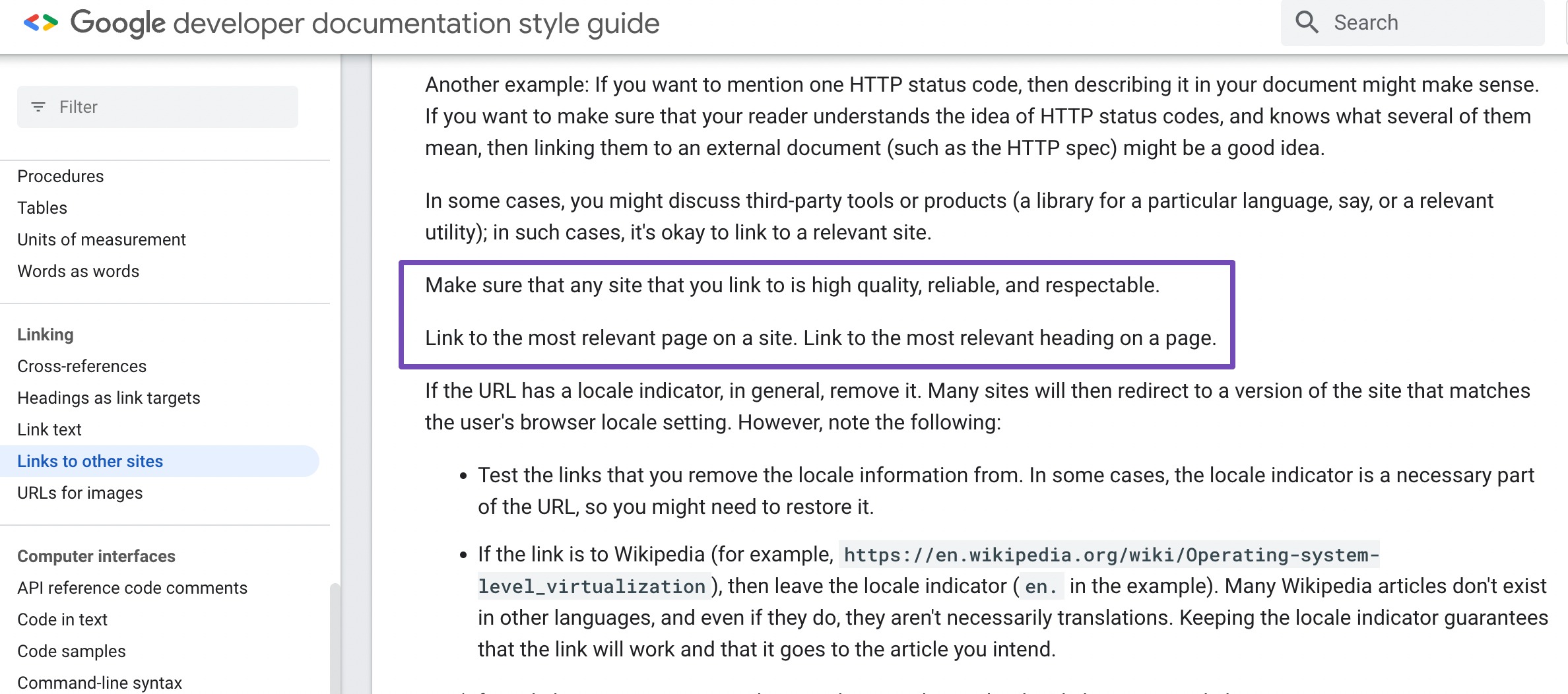
Like internal links, Rank Math checks if you’re linking to a few external websites. If you’re not, you’ll fail the test and need to add relevant links to external websites to pass this test.
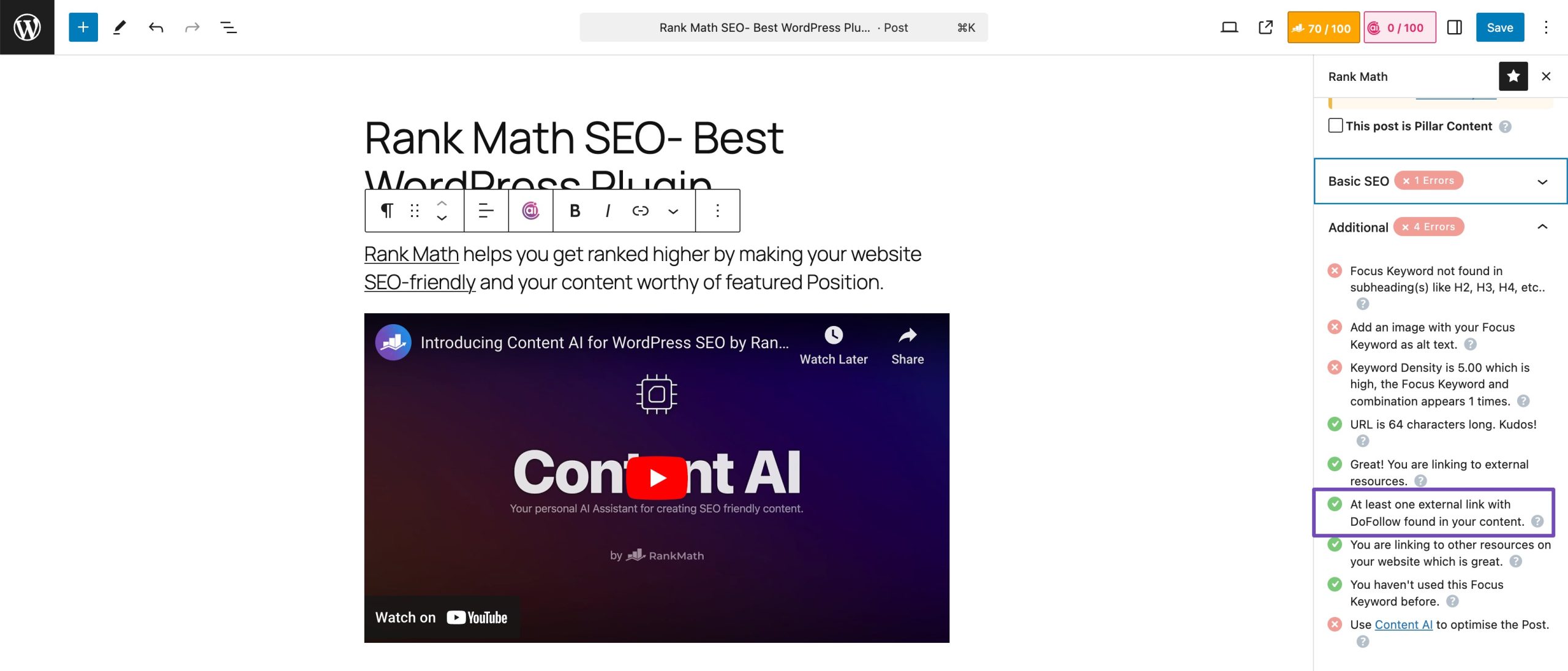
Just remember: quality over quantity. Link only when it adds genuine value, and always make sure your sources are reliable and up to date.
Quick Actionable Tips for External Linking:
- Choose Authority First – Link to trusted, high-quality sources to build credibility.
- Stay Relevant – Only link to content directly related to your topic.
- Avoid Broken Links – Check your external links regularly so your audience never hits a dead end.
- Link in Moderation – A few well-placed links work better than overloading your content.
4 Frequently Asked Questions
What is the difference between on-page SEO and off-page SEO?
On-page SEO concentrates on optimizing factors within a webpage, while off-page SEO deals with external factors. Simply put, on-page SEO involves elements entirely under your control, whereas off-page SEO involves factors beyond your control.
How can I measure the success of my on-page SEO efforts?
You can measure on-page SEO success using tools like Google Analytics and Google Search Console. Monitor organic traffic, keyword rankings, click-through rates, and user engagement metrics to assess your on-page SEO performance.
How often should I update my content for on-page SEO?
Regularly updating and refreshing content can help maintain its relevance and search engine rankings.
What is the ideal keyword density for on-page SEO?
There is no specific ideal keyword density. Focus on using keywords naturally and prioritize quality content over keyword density.
How long does it take to see results from on-page SEO
While you might notice small ranking or traffic improvements in a few weeks, significant results often take a few months.
5 Conclusion
Mastering on-page SEO is a powerful step toward building your online success.
By fine-tuning elements like your title tags, meta descriptions, content, URLs, and internal links, you’re not just improving rankings, you’re creating a better experience for your audience.
Remember, SEO isn’t a one-time task. It’s a journey where every update and improvement brings you closer to your goals. Stay curious, keep experimenting, and adapt as the industry evolves.
The more you implement and refine these strategies, the more you’ll see your site climb the search results, attract visitors, and provide real value that keeps them coming back.
If you like this post, let us know by Tweeting @rankmathseo.
